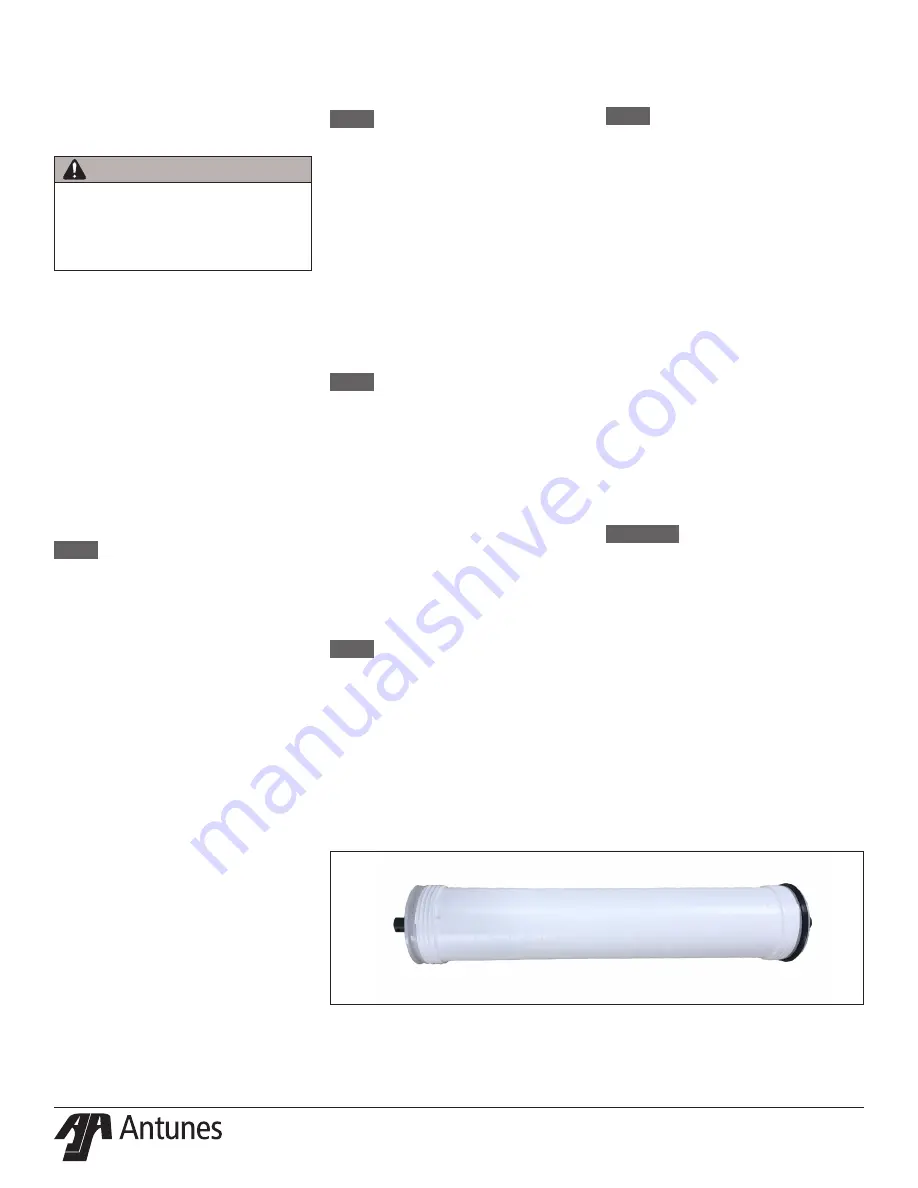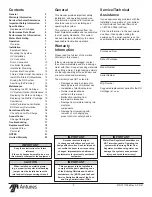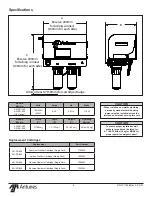
®
P/N 1011596 Rev. A 05/21
14
Sanitizing the Plumbing
The plumbing from the RO System
must be sanitized to eliminate possible
contamination that may have occurred
during the installation process.
One ounce (30 ml) of liquid chlorine bleach
(regular bleach, unscented 5.25 % - 6 %
sodium hypochlorite) or Kay-5 sanitizer
solution (Sodium Dichloro-s-Triazinetrione
Dihydrate, 6%) or equivalent can be used
to sanitize the plumbing.
The Kay-5 sanitizer solution is made by
dissolving a 1 oz. packet of Kay-5 powder
in 2 oz. (60 ml) of clean warm water. This
can be done by removing 1 inch from the
top of the Kay-5 packet and adding the 2
oz. of warm water to the packet. Mix with
a coffee stirrer to dissolve. When added to
the plumbing from the RO System, this will
create a 60-100 ppm chlorine solution.
NOTE:
Follow the handling and safety
instructions supplied with the
sanitizer.
1.
Follow the steps in the
Rinsing the
RO System
section of this manual.
2.
Turn off the water to the system.
3.
Close the Tank valve.
4.
Allow the system and plumbing
to drain by opening the line
downstream to the RO System.
5.
Disconnect the line to the
equipment being served at the Tee
fitting and pour the sanitizer into
the line using a cup or funnel. Be
careful not to spill the sanitizer onto
clothing or skin.
6.
Reattach the line to the Tee fitting.
7.
Slowly turn on the Tank valve and
allow water to flow through the line
and out to the equipment.
8.
Let stand without water flow for at
least 15 minutes to allow time for
the pipes to be sanitized.
9.
After 15 minutes without water flow,
open the line at the equipment and
allow water and sanitizer to flow
until the presence of sanitizer is
gone.
10.
Reconnect all lines and turn on
water to the RO. The system is now
ready for use.
Maintenance
Replacing the RO Cartridge
NOTE:
Always install a new Carbon
cartridge after replacing the RO
Cartridge.
1.
Turn off water to the system by
closing the feed water valve and
unplug the system power cord from
the outlet.
2.
Close the tank valve.
3.
Depressurize the system.
4.
Pull out the tube which is inserted
into the RO housing’s inlet.
5.
Using the supplied wrench, unscrew
the RO housing end cap and
remove the old RO cartridge.
NOTE:
Water may drain from the
system and cartridge as it is
removed.
6.
Unwrap the new cartridge and
record the serial number of the new
cartridge.
7.
Check to make sure that all
the O-rings in the end caps are
lubricated with a food grade silicone
lubricant.
8.
Insert the RO membrane into the
housing. The RO membrane must
be installed with the brine seal on
the right side, nearest to the RO
membrane housing inlet.
NOTE:
Make sure the cartridge is
installed with the brine seal to
the right (RO housing inlet), if
not, the system will not work
properly.
9.
Reattach the RO membrane
housing end cap. Reinstall the
tube that was removed previously
by pushing it into the RO housing
inlet. Make sure the tubing is fully
engaged in the fitting.
Figure 13.
RO Cartridge
NOTE:
Failure to fully engage the
tubing could result in leaks and
flooding.
10.
Turn on the feed water and plug the
system power cord into the outlet.
Air and water should flow out of the
brine (drain) tubing and permeate
tubing.
11.
Observe the system for leaks,
especially at the newly replaced
cartridge.
12.
The system should be flushed as
described in the installation section
under RINSING THE RO SYSTEM.
13.
When flushing is complete, open the
tank valve.
14.
Record the next change date of the
RO Cartridge.
UV System (Option)
Maintenance
The UV system requires periodic
maintenance in order to function properly.
WARNING:
The UV light given off by
the UV bulb can cause serious
burns to unprotected eyes
and skin. Do NOT perform any
maintenance tasks with the bulb
plugged in and powered on.
Pay attention to the following guidelines
when working with the UV light:
y
Never look directly at an
illuminated UV lamp
y
Always unplug the UV unit before
performing any work on the UV
bulb or disinfection system
y
Never operate the UV bulb
outside of the UV housing
WARNING
Do not pour sanitizer into the system
inlet! The RO membrane can be
destroyed if exposed to sanitizer. Only
the downstream plumbing from the
system should be sanitized.








































